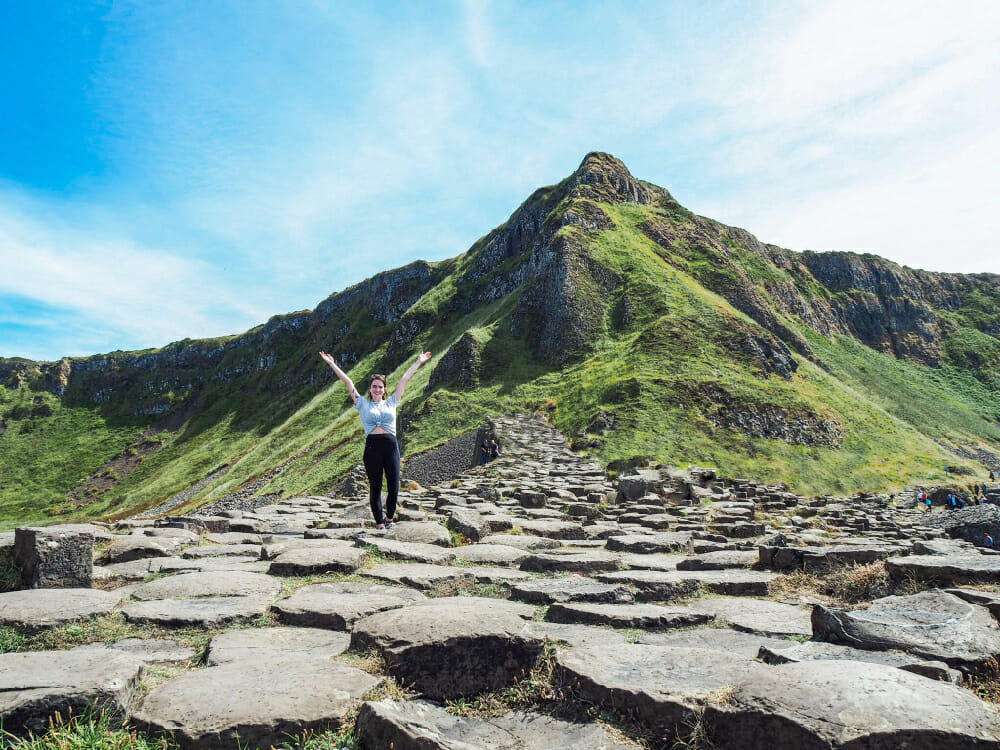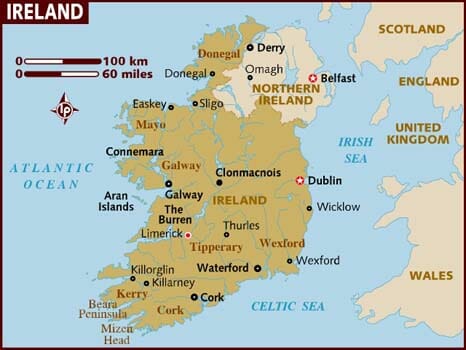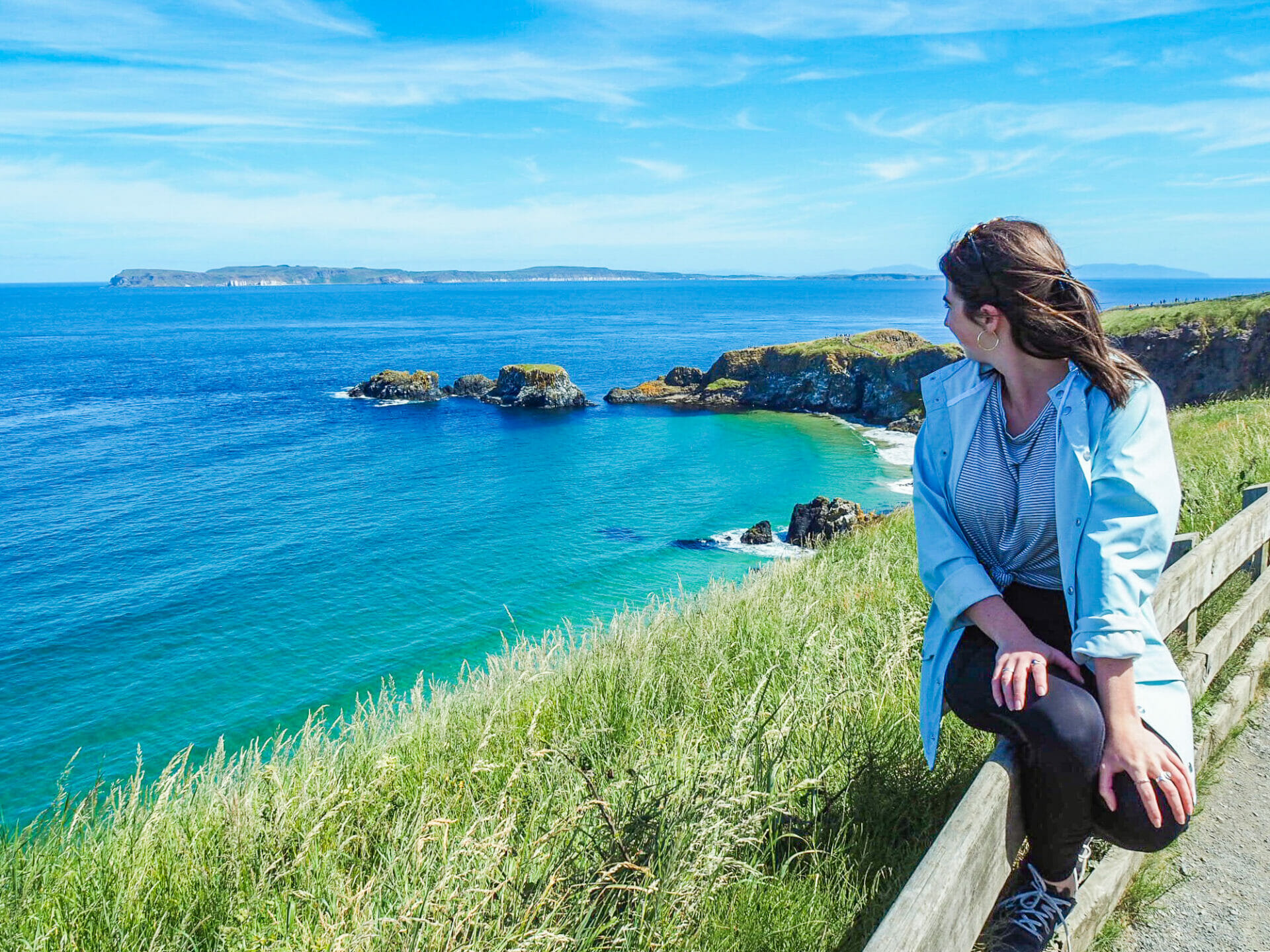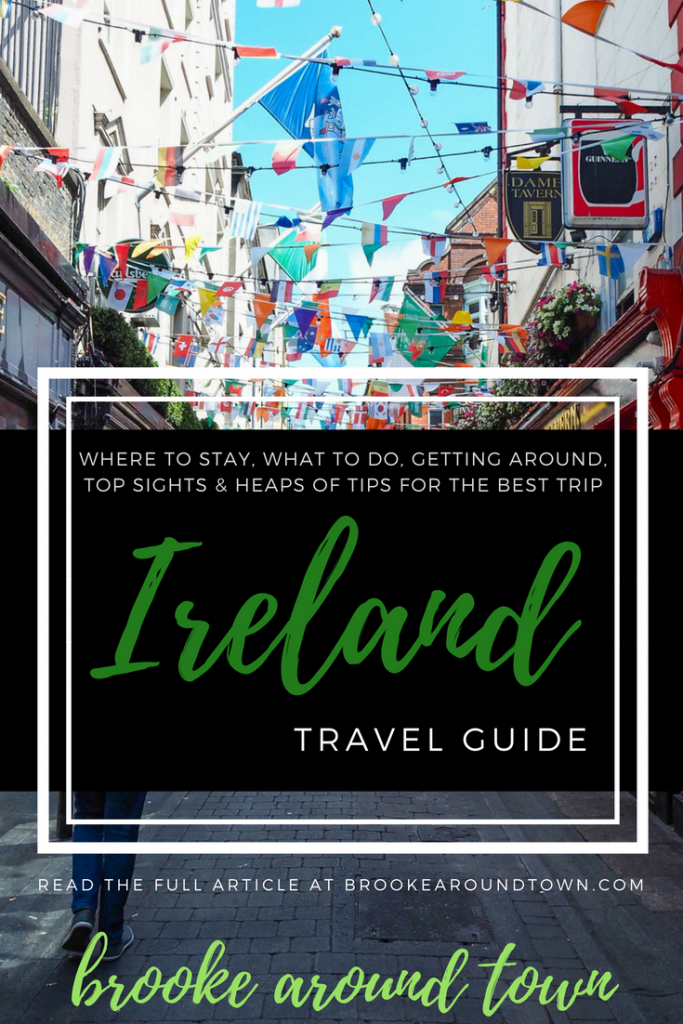
Last Updated on 5 June 2022
Ireland is perhaps best known for free-flowing Guinness, lucky leprechauns, and a love of all things potato, but there’s actually so much more to this little island than pubs and shamrocks. Discover rugged coastline and lush forests steeped in local legend, rolling countryside as far as the eye can see, buzzing cities filled with the friendliest people (and, ok, quite a lot of pubs), and some of the richest culture and history you’re likely to find anywhere. We always talk about the Irish being lucky, and it’s easy to see why— this country is more than a little magical, so don’t be surprised if you’ve fallen totally in love in a matter of days. This travel guide contains everything you need to know before visiting Ireland, including when to visit, how to get around, top sights, itinerary recommendations, typical expenses, a packing list & heaps more.
Republic of Ireland

Courtesy of Lonely Planet
Population: 4.8 million
Capital: Dublin
Language: English & Irish— all official signs will be written in both languages, but absolutely everyone speaks English, so there is no language barrier whatsoever
Currency: Euro— major credit cards accepted pretty much everywhere
Power: Type G plug (used in the UK) at 230V— Americans need to carefully check appliances like hairdryers before using them, but almost all modern electronics are dual voltage, so chargers are typically fine
Visa: No visa is needed to visit Ireland as a tourist (90 days) for citizens of most countries, including Australia, America, and UK (Brits actually don’t even need a passport, as Ireland is part of the Common Travel Area)
Good to know: Although sharing an island, the Republic of Ireland is a distinct country from Northern Ireland, which is part of the United Kingdom. Still, it’s extremely easy to cross the border between the two countries and you typically won’t even need to show a passport.

The most amazing scenery near the rope bridge
Planning your trip to Ireland
When to visit Ireland
Ireland is notoriously grey and cold, so summer is the best chance you’ll have of scoring a few sunny days. If you get super lucky, you may even visit during an unusual Irish heatwave and find 26C days, but even in summer, the average temperature hovers around the high teens and it’s not unusual to encounter quite a bit of rain. Unfortunately, the nice(r) summer weather also brings the largest number of tourists, so you can expect a decent number of other people at all the main attractions and some associated price hikes at hostels and hotels. Still, I think it’s worth it for the potential of blue skies, so June-August is the way to go!
Getting to Ireland
The easiest way to get to Ireland is to fly into the international Dublin Airport, which is only a 20-30min drive (depending on traffic) from the centre of the city. Alternatively, ferries operate between Liverpool (UK) and Dublin or Belfast (Northern Ireland) several times a day.
Getting around Ireland
Transport between cities
Car hire in Ireland
Unfortunately, many of Ireland’s best natural attractions are not readily accessible via public transport, leaving you to either hire a car and brave the narrow country roads or join a tour. If you’re a confident driver and navigator (and over 25), it’s probably best to plan a self-drive around the country, as it will give you the most flexibility and freedom to discover the country’s hidden gems. Hiring a car for a week will range from 100-200€ depending on time of year, insurance, and the specific car.
Day tours in Ireland
If you’re not keen on driving, there are heaps of day tours departing from Dublin, Cork, Galway, and Limerick that will take you all around the island (including Northern Ireland) and are relatively inexpensive. I’m not usually a fan of organised tours, but I found that this was a great, stress-free way to explore Ireland in lieu of hiring a car. One-day tours were 50-100€ depending on inclusions.
Transport within the city
Public transport in Ireland
Within the main cities, and particularly in Dublin, there is excellent public transport that will get you anywhere you need to go. The DART (train), the Luas (tram), and the network of buses (which all have chargers and free wifi) connecting greater Dublin are really easy and safe to use, and are also quite inexpensive.
Buy tickets at the tram stops and train stations directly, pay (exact change) for a ticket on the bus, or grab a Leap card at one of the many newsagency or off-licence locations throughout the country, which will get you unlimited travel across the network for 24hrs (€10), 3 days (€19.50), or 7 days (€40). All of Ireland’s cities are also very walkable, so it’s possible to avoid transport entirely if you are just exploring the centre of the city.
Uber in Ireland
If you aren’t keen on buses and trams, there’s also the option to use Uber—technically, the country doesn’t allow Uber, but you can use the app to book metered taxis that will still use your stored credit card and track the driver’s arrival as usual. To give you an idea of price, an Uber from the airport to Dublin city is about €20.

Cliffs of Moher
What to do in Ireland
Top sights & destinations in Ireland
Wicklow Mountains
Rising just behind Dublin, the Wicklow Mountains are an outdoor-lover’s paradise within close reach of the city. Go for a walk in Ireland’s largest national park, exploring the many forest paths, country roads, and beautiful waterways that make this area so special, making sure to visit the stunning Lough Tay, called the “Guinness Lake” for its close resemblance to the country’s drink of choice.
Read more: GETTING OUTDOORS IN THE WICKLOW MOUNTAINS
- Unreal scenery above Lough Tay, the so-called Guinness Lake
Dublin
Ireland’s capital is always abuzz with activity, largely thanks to its lively pub culture and busy night life, and is centred around the River Liffey, only about 10min away from the seafront. Visit the famous Temple Bar district for some of the best eating, drinking, and dancing options (Pantibar is an awesome gay bar near the centre), take a free walking tour around the city to see Dublin Castle, Trinity College, and other main sites, or check out the world-famous Guinness Storehouse.
Read more: WELCOME TO IRELAND: EXPLORING DUBLIN & BRAY
12 AMAZING THINGS TO DO IN & AROUND DUBLIN, IRELAND
- Me & Josey with our 10am pints of Guinness
Wild Atlantic Way & Cliffs of Moher
Possible as a day trip from either Galway or Dublin, the Cliffs of Moher are probably Ireland’s most popular tourist destination, dramatically towering 200m above the Atlantic. Enjoy these sandstones cliffs and many other beautiful natural sites along the Wild Atlantic Way, including the Burren and the nearby Aran Islands.
Read more: WILD ATLANTIC WAY: ADVENTURING FROM THE CLIFFS OF MOHER TO GALWAY CITY
- This grass gave me a leg rash, but it was worth it
Giant’s Causeway, Northern Ireland
Easily reached on a day tour from Dublin or Belfast, the Giant’s Causeway is a massive expanse of 50,000 interlocking hexagonal basalt columns created some 60 million years ago that is a wonder of geology as much as it is the stuff of Irish legend. Explore the volcanic scenery of the Antrim Coast on one of several footpaths, and then learn more about the science and history of the area in the Visitor’s Centre.
Read more: EXPLORING NORTHERN IRELAND: GIANT’S CAUSEWAY, CARRICK-A-REDE & BELFAST
- Hexagonal columns every way you look
Galway
Widely regarded as the heart of culture in Ireland, this lively city situated just off the Atlantic coast is overflowing with packed pubs, gin palaces, fiddle-wielding buskers, and boutique shops. Check out the absolutely enormous King’s Head pub for great food and even better drinks and then visit Murphy’s for some unique ice cream, which you can enjoy as you wander the busy, music-filled streets.
Read more: WILD ATLANTIC WAY: ADVENTURING FROM THE CLIFFS OF MOHER TO GALWAY CITY
- Buskers in Galway
Carrick-a-Rede rope bridge, Northern Ireland
Not far from the Giant’s Causeway up north, this rope bridge connecting the mainland to tiny Carrick-a-Rede Island over an amazingly vibrant coastline is one of the most beautiful places you can visit in Ireland, and one that will instantly make you wonder if you’ve somehow been transported to the Mediterranean.
Read more: EXPLORING NORTHERN IRELAND: GIANT’S CAUSEWAY, CARRICK-A-REDE & BELFAST
- Carrick-a-Rede island and the little rope bridge in the distance
Belfast, Northern Ireland
The capital of Northern Ireland is dominated by impressive historical buildings and steeped in history, having been a main centre of former IRA conflict. Learn all about Ireland’s storied past on a Black Taxi Tour of the city, explore beautiful City Hall, or visit the famous Titanic Museum.
Read more: EXPLORING NORTHERN IRELAND: GIANT’S CAUSEWAY, CARRICK-A-REDE & BELFAST
- The stunning exterior of Belfast City Hall
Check out more detailed information on all of these recommendations:
12 AMAZING THINGS TO DO IN & AROUND DUBLIN, IRELAND
Itinerary recommendations for Ireland
With a hire car and a reasonable amount of time, it would be possible to build yourself a wonderful road trip itinerary, exploring all the hot spots and hidden gems of this small island. All of the places described above are well-worth a visit, but additional days should be given to each Dublin, Belfast, and Galway to really explore the unique culture and history of the cities.
The advantage of a driving holiday is that you won’t just be confined to the main cities, though, so make the most of your mobility and explore the little country towns that probably hold just as much, if not more, culture and history. A good place to start would be Dublin, as it is the main point of arrival, and then travel out to the Wicklow Mountains, visiting small villages like Enniskerry and Glendalough along the way, before continuing onwards around the coastline, making it to the famous Wild Atlantic Way and up to Northern Ireland.
If a self-drive isn’t on the cards for you, I’d recommend basing yourself in Dublin and exploring the country through a series of day trips. Every destination on the list above is accessible via bus, train, or day tour from Dublin, so booking accomodation in the city and just returning every night or every second night is a great way to keep things simple and still see heaps of new places every day. A week is a great amount of time to see all of these places,.
Best food & drink in Ireland
Unsurprisingly, Ireland’s pervasive pub culture means that you’ll be eating most of your dinners at one of the thousands of lively pubs throughout the country, where you can find amazing traditional meals. Some of my favourite food and drink from Ireland:
- Guinness Stew: a thick and flavourful beef stew made with Guinness
- Shephard’s Pie: delicious mince, veggie, and mashed potato pie topped with cheese
- Boxty: amazing potato pancake, usually topped with sour cream and chives
- Guinness: Ireland’s famous and surprisingly delicious dark beer. Apparently there’s a slightly different process for making Guinness that’s safe to travel, so any exported Guinness you’ve had at home just won’t be the same as what you’ll find on the island
- Jameson Irish Whiskey: even for those who don’t typically enjoy whiskey, Jameson with ginger beer is definitely worth a try
- Gin & tonic: Ireland has caught onto the worldwide gin craze, and hard. Pubs can have as many as 30 or 40 different varieties of amazing local gins, flavoured with botanicals ranging from rhubarb to tea to elderflower to (my personal favourite) sea salt.
Recommended reading & watching
Check out a few amazing books that centre around Ireland, like the famous Dubliners by James Joyce, The Trick to Time by Kit de Waal, or Troubles by J G Farrell, which will paint a picture of both past and present Ireland. The best way to get into the mood for this trip, though, is just to watch Riverdance. If you aren’t lucky enough to be in possession of VHS tapes from your childhood, just hop on Youtube to get a feel for one of Ireland’s best cultural traditions, set to the soundtrack of some spectacular Irish music.

The whiskey bar in full-swing at 10am
Practical considerations for Ireland
Health & safety in Ireland
Ireland is generally quite safe, even for solo female travellers walking around in the evening, so just take normal safety precautions and that should be sufficient to avoid incident. There also aren’t any special vaccines or medicines recommended for a visit to Ireland.
Packing list for Ireland
Aside from all the usual bits, make sure to throw in the following items for your visit to Ireland:
- Joggers, or other comfortable walking shoes
- Rain jacket, even in summer!
- Warm jumper and jeans, yes, even in summer
- Ireland travel adapter
Typical expenses in Ireland
Ireland is a reasonably expensive country, particularly when it comes to food and accommodation, but it’s still possible to stick to a budget if you’re a savvy traveller. Here are some typical prices you can expect to pay for a variety of items:
Dorm bed in a nice hostel: €10-20
Airbnb, whole apartment: €40-60
Hotel room for two: €70-120
Lunch at a casual restaurant: €6-10
Pub lunch/dinner: €15-20
Dinner at a restaurant: €25-40
Pint of Guinness: €4-8
Gin & tonic from a pub: €6-8
Can of craft beer from the supermarket: €2-5
Bottle of water: €1
Snack from the supermarket/service station: €3
Tips: It’s obviously appreciated to tip your server or tour guide, but it’s not expected!
Ticket on the tram/bus/train: €3
Bus from the airport: €6
Uber from the airport: €20
Basic car hire: €20-60/day
Fuel: €1.40/L
Day tour (Cliffs of Moher, Northern Ireland): €40-70
Tour in the city (Guinness Storehouse, Jameson Distillery): €17-20
Entry to an attraction (rope bridge, Long Room Library): €10-14
More about Ireland on Brooke Around Town
WELCOME TO IRELAND: EXPLORING DUBLIN & BRAY
EXPLORING NORTHERN IRELAND: GIANT’S CAUSEWAY, CARRICK-A-REDE & BELFAST
GETTING OUTDOORS IN THE WICKLOW MOUNTAINS
WILD ATLANTIC WAY: ADVENTURING FROM THE CLIFFS OF MOHER TO GALWAY CITY









